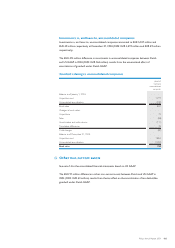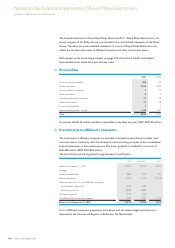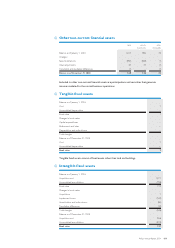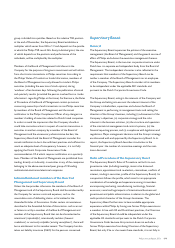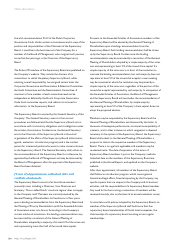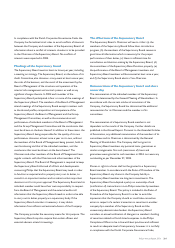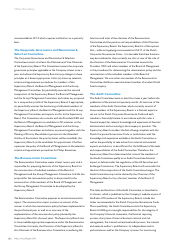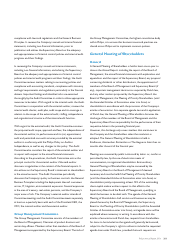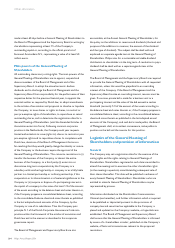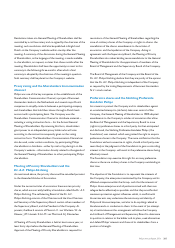Philips 2004 Annual Report Download - page 196
Download and view the complete annual report
Please find page 196 of the 2004 Philips annual report below. You can navigate through the pages in the report by either clicking on the pages listed below, or by using the keyword search tool below to find specific information within the annual report.Corporate governance of the
Philips Group
General
Koninklijke Philips Electronics N.V. (the ‘Company’) is the parent
company of the Philips Group (‘Philips’ or the ‘Group’).
The Company, which started as a limited partnership with the
name Philips & Co in 1891, was converted into the company with
limited liability N.V. Philips’ Gloeilampenfabrieken on September
11, 1912. On May 6, 1994 the name was changed to Philips
Electronics N.V., and on April 1, 1998 the name was changed to
Koninklijke Philips Electronics N.V. Its shares have been listed on
the Amsterdam Stock Exchange Euronext Amsterdam since 1913.
The shares have been traded in the United States since 1962 and
have been listed on the New York Stock Exchange since 1987.
Over the last decades the Company has pursued a consistent
policy to enhance and improve its corporate governance in line
with US, Dutch and international (codes of) best practices. The
Company has incorporated a fair disclosure practice in its investor
relations policy, has strengthened the accountability of its
executive management and its independent supervisory directors,
and has increased the rights and powers of shareholders and the
communication with investors. The Company is required to
comply with inter alia the US Sarbanes-Oxley Act, New York
Stock Exchange Rules and related regulations, insofar as applicable
to the Company. A summary of significant differences between the
Company’s corporate governance structure and the New York
Stock Exchange corporate governance standards is published on
the Company’s website.
In this report, the Company addresses its overall corporate
governance structure and states to what extent it applies the
provisions of the Dutch Corporate Governance Code of
December 9, 2003 (the ‘Dutch Corporate Governance Code’).
Subject to the adoption by the Annual General Meeting of
Shareholders to be held on March 31, 2005, of the proposal to
amend the Articles of Association, the Supervisory Board and the
Board of Management, which are responsible for the corporate
governance structure of the Company, are of the opinion that the
vast majority of the principles and best practice provisions of the
Dutch Corporate Governance Code that are addressed to the
Board of Management and the Supervisory Board, interpreted and
implemented in line with the best practices followed by the
Company, are being applied. Some recommendations are not
(fully) applied, and the reasons for these deviations are set out
hereinafter. Deviations from aspects of the corporate governance
structure of the Company that are described in this report, when
deemed necessary in the interests of the Company, will be
disclosed in the Annual Report. Substantial changes in the
Company’s corporate governance structure – including substantial
amendments to the Rules of Procedure of the Supervisory Board
and the Board of Management respectively – and in the Company’s
compliance with the Dutch Corporate Governance Code shall be
submitted to the General Meeting of Shareholders for discussion
under a separate agenda item.
Also in connection with the implementation of the Dutch
Corporate Governance Code and new Dutch legislation, a
proposal shall be made to the 2005 Annual General Meeting of
Shareholders to amend the current articles of association of the
Company. Upon the General Meeting of Shareholders adopting
this proposal, the Company’s priority shares will be cancelled and
the thresholds for overruling the binding recommendation for
appointments of members of the Board of Management and the
Supervisory Board will be changed. The proposal to amend the
articles of association also contains detailed provisions on dealing
with conflicts of interests of members of the Board of
Management and stipulates that resolutions that are so
far-reaching that they would significantly change the identity or
nature of the Company or the enterprise shall be subject to the
approval of the General Meeting of Shareholders.
Once the articles of association, upon adoption by the General
Meeting of Shareholders, have been amended (the ‘Amended
Articles of Association’), any reference to the Meeting of Priority
Shareholders and priority shares should be disregarded since
priority shares will no longer exist.
Board of Management
General
The executive management of Philips is entrusted to its Board of
Management under the chairmanship of the President/CEO and
consists of at least three members (currently four). The members
of the Board of Management have collective powers and
responsibilities. They share responsibility for the management of
the Company, the deployment of its strategy and policies, and the
achievement of its objectives and results. The Board of
Management has, for practical purposes, adopted a division of
responsibilities indicating the functional and business areas
monitored and reviewed by the individual members. According to
the Company’s corporate objectives and Dutch law, the Board of
Management is guided by the interests of the Company and its
affiliated enterprises within the Group, taking into consideration
the interests of the Company’s stakeholders, and is accountable
for the performance of its assignment to the Supervisory Board
195Philips Annual Report 2004


